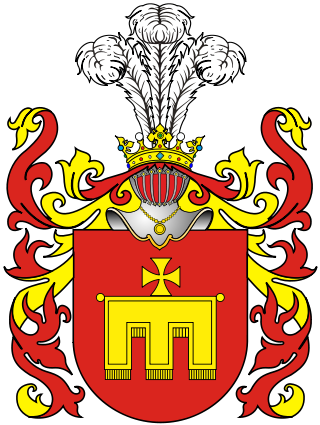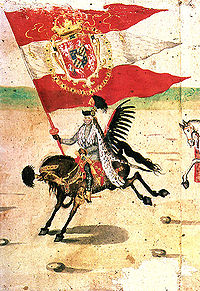
John III Sobieski was King of Poland and Grand Duke of Lithuania from 1674 until his death in 1696.

Tykocin is a small town in north-eastern Poland, with 2,010 inhabitants (2012), located on the Narew river, in Białystok County in the Podlaskie Voivodeship. It is one of the oldest towns in the region, with its historic center designated a Historic Monument of Poland.

Janina is a Polish nobility clan coat-of-arms. Borne by several noble families descended in the-male line from the medieval lords of Janina or legally adopted into the clan upon ennoblement.

Andrzej Potocki was a Polish nobleman, magnate, politician, general and military commander. He held a number of political and military positions and was a skilled commander and successfully protected the Eastern Borderlands of the Polish–Lithuanian Commonwealth from the invading armies of Ottoman Turkey, Cossacks and Tatars.

Prince Jerzy Sebastian Lubomirski was a Polish noble (szlachcic), magnate, politician and military commander, and Prince of the Holy Roman Empire. He was the initiator of the Lubomirski Rebellion of 1665–1666 against royal authority.

Prince Aleksander Ostrogski was a nobleman of the Polish–Lithuanian Commonwealth.

Krzysztof Wiesiołowski was a Polish nobleman, starost of Tykocin and Supraśl, Stolnik of Lithuania and Ciwun of Wilno before 1620, Court Marshal of Lithuania from 1619, Krajczy of Lithuania from 1620, and Grand Marshal of Lithuania from 1635.

Marek Sobieski was a Polish nobleman, starosta of Krasnystaw and Jaworów, and the older brother of King John III Sobieski of Poland. He graduated from Nowodworek College in Kraków and Kraków Academy, then traveled and studied in Western Europe. After returning to Poland in 1648 he fought against the Cossacks and Tatars at the Siege of Zbaraż and at the Battle of Beresteczko. He was taken captive by Tatars in 1652 and then killed by Cossacks.

Prince Wladysław Dominik Zasławski-Ostrogski was a Polish nobleman (szlachcic) of Ruthenian stock. Prince of the Princely Houses of Poland, Ostroh Ordynat, Grand Koniuszy of The Crown.

Prince Konstanty Wiśniowiecki (1564–1641) was a Ruthenian nobleman of Kingdom of Poland, voivode of Belz since 1636, of Ruthenia since 1638 and starost of Czerkasy and Kamieniec was a wealthy, powerful and influential magnate, experienced in both politics and warfare.

Gniew is a historic town situated on the left bank of the Vistula River, in the Pomeranian Voivodeship, in northern Poland. It has 6,870 inhabitants (2016). It is one of the oldest towns in Eastern Pomerania, and is renowned for its medieval brick gothic Castle, which has become one of the region's most recognizable monuments.

The House of Wiśniowiecki was a Polish-Lithuanian princely family of Ruthenian-Lithuanian origin, notable in the history of the Polish–Lithuanian Commonwealth. They were powerful magnates with estates predominantly in Ruthenia on lands of the Crown of the Kingdom of Poland, and they used the Polish coat of arms of Korybut.

Marianna Wiśniowiecka was Ruthenian noblewoman (szlachcianka) in Kingdom of Poland, the oldest daughter of Prince Konstanty Wiśniowiecki and Anna Zahorowska of Ostoja Clan.

Teofila Zofia Sobieska, née Daniłowicz was a Polish noblewoman (szlachcianka), mother of Jan III Sobieski, King of Poland.

Prince Aleksander Janusz Zasławski-Ostrogski (1650–1682) was the last male representative of the Ostrogski princely line. He was the 4th ordynat of the Ostrogski Family Fee Tail.

Jakub Szydłowiecki was a Polish nobleman and politician. In the years 1493-1501 he was Burgrave of Kraków and was a courtier of the king from 1496, Treasurer of the Crown Court in 1497, Grand Teasurer of the Crown from 1501 to 1506, and castellan and starost of Sandomierz, Sochaczew and Łęczyca.

Count Marcin Kazimierz Kątski of Brochwicz was a Polish nobleman, politician, diplomat, scholar, military commander, General of Artillery of the Crown (1667–1710), the Voivode of Kiev (1684–1702) and Castellan of Kraków (1706–1710).

Aleksandra Marianna Wiesiołowska was the daughter of magnate Marek Sobieski and Jadwiga Snopkowska.

The Zebrzydowski was a Polish noble family.




















